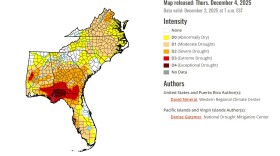

More than 100 wildfires were burning throughout Florida at the end of April, 14 million state residents are living in a region gripped by drought, and bans against burning anything outdoors are in effect in nearly a third of the counties.
The drought that has been drying out Peninsular Florida since the beginning of the year grew from moderate to severe last week in the greater Fort Myers area, according to the federal Drought Monitor.
Lee and DeSoto counties are recording their driest year to date in 131 years.
Charlotte County has strict water conservation measures due to extreme heat and lack of rain, leading to higher water usage and potential strain on water systems. Collier and surrounding counties are experiencing severe drought with irrigation restrictions in place, and no significant rain is forecast.
Both the National Weather Service and the Climate Prediction Center forecast that it’s likely the lack of meaningful rainfall will continue. The drought is expected to persist -- or worsen -- across central and southern Florida at least into May.
Drought keeps pushing up a key index firefighters use to determine the wildfire threat by telling them how much water is in the soil. The Keetch-Byram Drought Index ranges from zero (saturated) to a desert-like 850. In Southwest Florida, Lee, Collier, and Hendry have topped 700 in recent days. So has every county in Southeast Florida, including Monroe County.
“We're on the edge,” said David White, a battalion chief with the Nokomis Fire Department north of Venice in Sarasota County. “We're definitely worried about it, being that it hasn't rained in a while.”
“We have meetings about it every morning, about staying hydrated, keeping an eye on the weather. What's it going to do in the afternoon? Are we going to get afternoon thunderstorms with dry lightning and no rain? The guys are definitely keeping an eye on it here every day.”
‘Big if’

Drought is doing its damage.
The lush, green grass on many landscaped lawns just a few months ago has been burned away by the strong Florida sun. With no ability to water due to conservation measures those yards now feature soil that is dry, sandy, and brown.
The Florida Forest Service reported just under 1,500 wildfires torched 61,000 acres in Florida at the end of April.
The much drier conditions have already contributed to several wildfires in South Florida, including last month when 26,719 acres were blackened near Homestead. Otherwise, the blazes have been on the smaller size, which doesn’t preclude them from belching a lot of smoke or being scary.
A five-acre brush fire in Naples last month had residents set to evacuate.


Small blazes are breaking out throughout Southwest Florida nearly every day now. Last week, a 13-acre wildfire in southern Charlotte County slightly injured a firefighter. A two-acre blaze east of Golden Gate in Collier County was quickly put out Wednesday and a 1.6 acre wildfire in the southwest corner of Hendry County was 80 percent contained as of Thursday morning.
Meteorologists point to climate change as the reason behind the persistent and dangerous drought that has been building in South Florida: higher than average temperatures and below-normal rainfall -- both short-term and long-term. Warmer ocean temperatures are being blamed for stronger, wetter hurricanes, which have felled trees and killed off underbrush, leaving the woods full of, essentially, tinder.
Tony Hurt, a National Weather Service meteorologist in Ruskin, hopes Florida’s mid-May rainy season starts on time, because if not …
“The drought, at this point, is now bumped up from moderate to severe,” in Fort Myers, he said. “There are burn bans basically in effect for just about every county south of I-4, so all of Southwest Florida has burn bans in effect.”
Hurt said the most recent outlook “really paints a picture of serious drought conditions down there,” and equally serious wildfire potential to the south, and in Lee County.
“Just with the conditions being so ripe, you know, it'd be easier to kind of lean toward, you know, more impactful events,” Hurt said. “But, of course, it all hinges on whether or not anything develops, but if it does come into play, then definitely the stage is there for it to be a pretty serious situation.”
“So, big if.”
Wildfire healthy
Wildfires, while often viewed as destructive, actually are an integral part of maintaining healthy forests.
They clear out dense underbrush and dead plant material, which helps return nutrients to the soil and allows more sunlight to reach the forest floor. This process encourages new growth and increases biodiversity.
Some tree and plant species even rely on fire for reproduction, as the heat can trigger seed release. And periodic fires help control pests and diseases, making forests more resilient and reducing the risk of more severe wildfires in the future.
If the drought stays in place and summer rains don’t start on time, it is not only wildlife that will be at risk of an odd summer cycle.
For example, water levels in the aquifer that is a key groundwater source for some residents of Cape Coral and parts of unincorporated Lee County have dropped to a critical threshold. The South Florida Water Management District had to implement water use restrictions to protect the aquifer and the drinking water supply since continued use at current rates could cause long-term damage underground.

Due to below-average rainfall, the Withlacoochee River system north of Tampa is experiencing steady declines in river levels. In March, the same thing happened in the Green Swamp area between Lakeland and Orlando, and the river’s flow declined by 80%. Just like the threat of a devastating wildfire, things won’t get better in the system until the summer rains begin.
Similar declines were observed downstream, with river levels and flows expected to continue dropping until the summer rainy season begins.
It’s typical for water levels in wells, lakes, rivers, and springs to decline during the October through May dry season. But this year’s conditions are drier than normal, especially in South Florida, leading to more pronounced drops in groundwater and surface water levels. Some areas are now several inches below their long-term rainfall averages, again exacerbating the declines in the amount of available water but in a different location.
While public water supplies remain sufficient for now, the ongoing drought is stressing regional water resources, and further restrictions may be necessary if dry conditions persist past mid-May.
Until recently, the national forecasting agencies were not seeing enough rain to qualify for typical Florida summer showers, but a few of the forecasters’ models are starting to look a little wetter in mid-to-late May.
But if that doesn’t happen, and people who rely on a typical summer rainy pattern for work, or food, can’t afford it, the American Red Cross said its volunteers can easily switch between hurricanes in one place, and drought in another, and still do what they do.
The American Red Cross is well aware of the wildfire threat in Southwest Florida, even as they have been preparing for hurricane season, which starts June 1.
“We are prepared for the upcoming hurricane season, but we are well aware of the wildfire threats that are happening across the state of Florida, and we are ready to respond,” Dariana Molina, a spokeswoman for the relief agency, said. “No matter the weather conditions, it's important for people to understand that they're very real and that they can impact you or anyone else you know, and so being prepared is key.”
Environmental reporting for WGCU is funded in part by Volo Foundation, a non-profit with a mission to accelerate change and global impact by supporting science-based climate solutions, enhancing education, and improving health.
Sign up for WGCU's monthly environmental newsletter, the Green Flash, today.WGCU is your trusted source for news and information in Southwest Florida.
We are a nonprofit public service, and your support is more critical than ever. Keep public media strong and donate now. Thank you.WGCU is your trusted source for news and information in Southwest Florida. We are a nonprofit public service, and your support is more critical than ever. Keep public media strong and donate now. Thank you.








